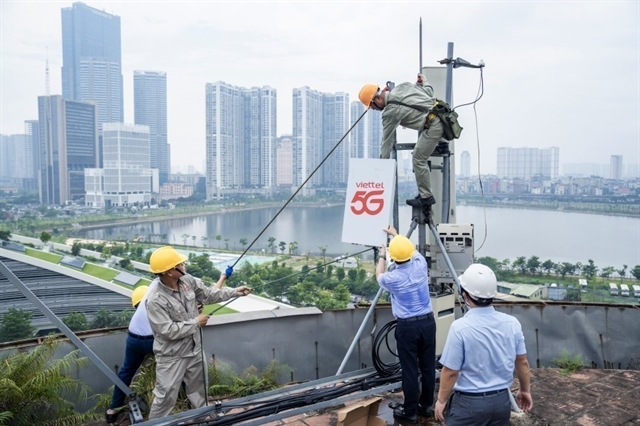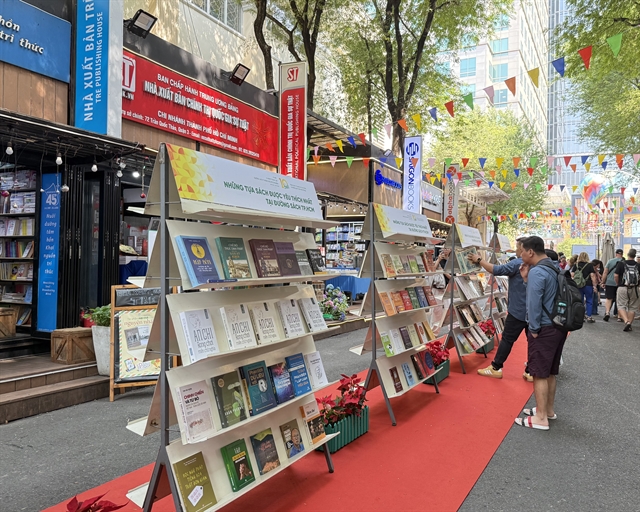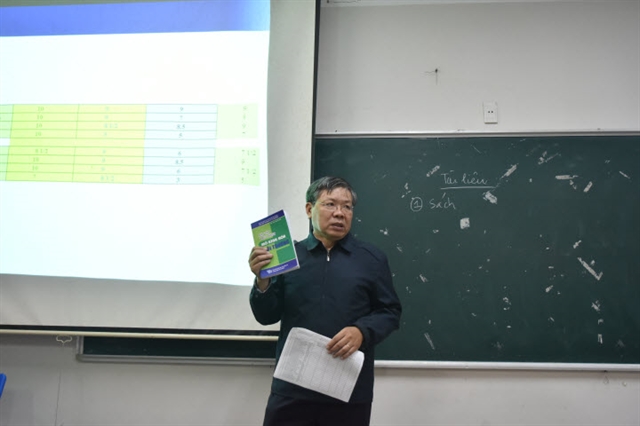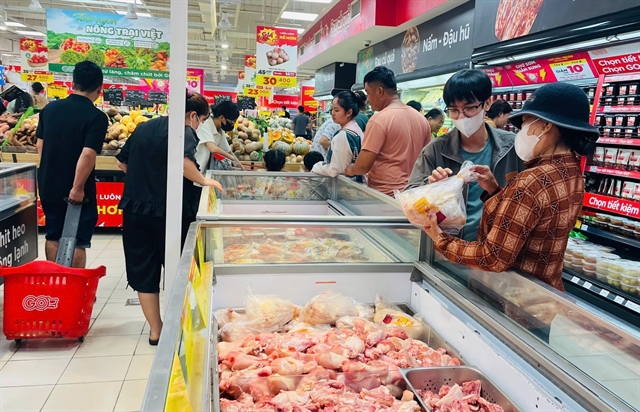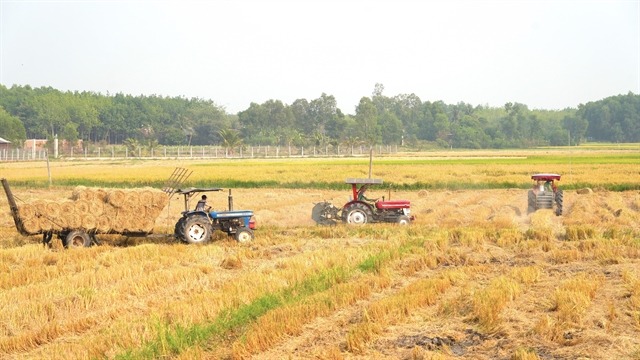 Society
Society

If it were not for the stench and the muddy colour of the waters, one could imagine it was Venice.
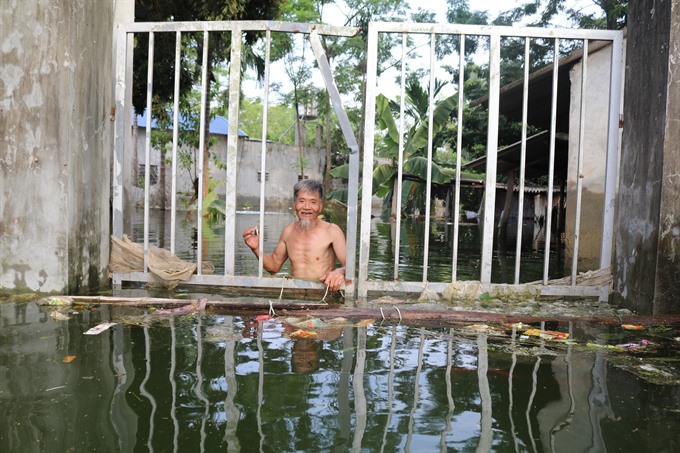 |
| Nguyễn Tất Thực, 74, a resident of Nam Hài Village, Chương Mỹ District, "enjoys" a smoke, standing in waist-deep water as trash piles up outside his inundated home. — VNS Photo Hồng Vân |
Thu Vân
HÀ NỘI — If it were not for the stench and the muddy colour of the waters, one could imagine it was Venice.
But there are no gondolas, of course. Just people making their way in makeshift boats, no romance in their hearts, just resilience and resignation to the problems they face.
Ten days after heavy rains flooded Nam Hài Village in Nam Phương Tiến Commune, Chương Mỹ District, Nguyễn Nhã Tuyển paddles a bamboo boat to check on his half-submerged house.
Located about 30km from downtown Hà Nội, Chương Mỹ District, along with Quốc Oai and Thạch Thất, were the hardest hit by the heavy downpours which began on July 21.
The rain has stopped, but his house remains flooded, and things won’t change in the foreseeable future. When the waters rose suddenly, he was only able to move some of his family’s belongings.
Tuyển’s family is one of 600 in the district that had to evacuate to higher ground, leaving behind whatever they could not take along: hundreds of pigs, thousands of chickens and ducks, furniture, bags of rice.
Just one person per family stayed nearby to guard the house, he said.
Tuyển said commune authorities had asked local residents to come and help with protecting the dyke along the Bùi River when it started raining. Later that day, when water overflowed on one side of the river, it was too late.
“We quickly came back to move our belongings, but could only save some,” he added.
It is no exaggeration to say that the flooding has turned residents’ lives upside down. Village roads have become rivers, paddy fields have become lakes, and there is no clean water and no electricity. Dry instant noodles are all they can depend on to keep hunger at bay.
“You ask me if I feel bad? Of course I feel bad, I feel miserable. But what can I do? Where can I go? Who will give me, or hundreds of people in my village, the money to move to another place?” Tuyển said.
“Living with it (the floods) is the only choice we have.”
The floods are one thing, the deluge of waste another, residents say.
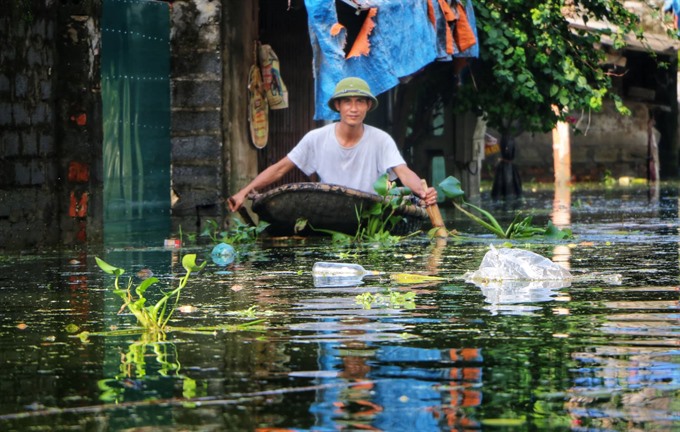 |
| As Nam Hài village roads are turned into rivers, along with water hyacinths, plastic trash is flowing in. — VNS Photo Đoàn Tùng |
Nguyễn Thị Quyết, 45, another resident of Nam Hài Village, said she was haunted by the smell of waste that flooded her house along with the waters.
“There were plastic bags, rotten leaves and even animal carcasses, everything floating on the water. It was horrible, I was so afraid we would get diseases from this waste,” she said.
Chewing some dry instant noodles, Quyết pointed at some dry tree trunks floating at the gate of her house, which was still deep in water. She said she had to use the trunks to prevent more waste from coming into the house.
Using the toilet and taking a shower with clean water is a luxury these days.
Quyết said they would just row the boat out of the house if they need to relieve themselves, embarrassed to say anything more.
“We still bathe with water from the well, which we know is not clean at all now, when everything is flooded. But we don’t have a choice. The luxury is that we can use two bowls of clean water here to finish,” she said, pointing at a paint bucket that holds fresh water now.
No blame game
Many villagers said they were experiencing a natural disaster and its aftermath.
“Natural disaster, it’s the will of Mother Nature. What can we do besides living with it?” said Nguyễn Tất Thực, 74, who has lived in the village all his life.
“Who do I blame? I do not blame anyone. I think nobody created this,” said Nguyễn Thị Thanh, another resident.
But there were other villagers who were not so accepting of their fate.
“Heavy rains happen every year, but in the past we never suffered such serious flooding,” said Nguyễn Nhã Tuyển.
“The most recent serious flooding, apart from 2017 and this year, was 10 years ago, in 2008. I think heavy rains and water from higher areas in Hòa Bình Province are worsening our situation,” he said.
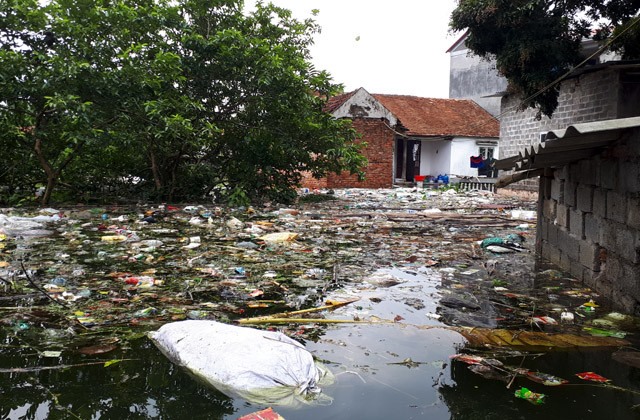 |
| Residents here are facing the prospect of living among garbage, which may cause a serious health problem. — VNS Photo |
Nguyễn Chiến Thắng, vice chairman of the People’s Committee of Nam Phương Tiến Commune, confirmed that the situation has worsened in recent years, blaming it on deforestation.
“In the past two years, the floods were worse than before,” he said.
The commune borders two districts, Lương Sơn and Kim Bôi, in the mountainous province of Hòa Bình. Heavy rains sent more water down to lower areas because “there are less trees to hold water than in the past, I think,” he said.
As of Wednesday, more than 3,600 houses in the outskirts of Hà Nội remained heavily flooded, 1,500 hectares of crops were damaged and nearly 56,000 domestic animals were dead or lost.
And the villagers cannot expect much respite in the coming days.
According to the Việt Nam’s National Centre for Hydro-Meteorological Forecasting, more flooding is expected in the coming months, until the rainy season comes to an end around early October.
Trần Quang Hoài, permanent member of the Central Steering Committee for Natural Disaster Prevention and Control, said the heavy and prolonged flooding situation in Chương Mỹ was caused mainly by deforestation in Hòa Bình Province along with heavy rains in the district.
However, Vũ Trọng Hồng, former Deputy Minister of Water Resources (now the Ministry of Agriculture and Rural Development), said that the serious flooding was caused by the flood water discharge from Hòa Bình Hydropower Plant.
On July 23, after the district was flooded, agriculture minister Nguyễn Xuân Cường had to directly request that the plant’s floodgate be shut down, Hồng said.
“Because downstream, rising waters had flooded tens of thousands of hectares of crops that were set to be harvested," he added.
"It can be said that the Hòa Bình Hydropower Plant has caused an artificial flood, the flood is not merely caused by local rain," Hồng said.
Thắng, chairman of Nam Phương Tiến Commune, said Chương Mỹ District was designed to be a floodplain.
The communal authority had proposed building a dyke wall along the current dyke of Bùi River.
“But when the water is too high, the floodplain area has to bear the brunt of flooding to spare other areas from inundation,” he said.
Chairman of Hà Nội People’s Committee Nguyễn Đức Chung at a meeting earlier this week said that local authorities of flood-hit areas in Chương Mỹ, Quốc Oai and Thạch Thất districts should find out ways to help local residents adapt to the flooding.
“Because these areas were designed within the floodplain planning of the city,” he said.
Chung also said that in the future, the city will seek more sustainable measures for these areas.
This only means that residents of Chương Mỹ District can expect their home to turn into a Venice when it rains here or in Hòa Bình again.
As a friend quipped: “Well, if they can find a way to keep the trash and filth at bay, maybe they can look forward to benefiting from some seasonal tourism.
“Flood water cruises, why not?” — VNS
 |
| A couple paddle a boat through the flooded village in Chương Mỹ District, Hà Nội. — VNS Photo Đoàn Tùng |
 |
| Many have been evacuated but those remaining still keep to their daily routine. — VNS Photo |
 |
| A child makes the most out of the flood. — VNS Photo |

